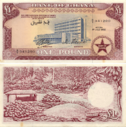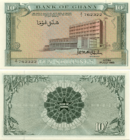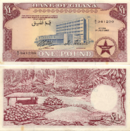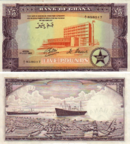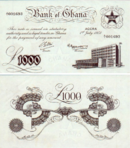Ghanaian pound facts for kids
Quick facts for kids Ghanaian pound |
|||||
|---|---|---|---|---|---|
|
|||||
| User(s) | |||||
| Subunit | |||||
| 1⁄240 | penny | ||||
| 1⁄20 | shilling | ||||
| Symbol | £ | ||||
| penny | d | ||||
| shilling | s. or /– | ||||
| Plural | pounds | ||||
| penny | pence | ||||
| shilling | shillings | ||||
| Coins | 1⁄2d, 1d, 3d, 6d, 1/–, 2/– | ||||
| Banknotes | 10/-, £1, £5, £1,000 | ||||
The Ghanaian pound was the money used in Ghana for a short time. It was used between 1958 and 1965. Before 1958, Ghana used a different currency called the British West African pound.
The Ghanaian pound was divided into smaller parts. One pound was equal to 20 shillings. Each shilling was then divided into 12 pence. So, a pound had 240 pence in total.
In 1965, Ghana changed its money again. They introduced a new currency called the cedi. One Ghanaian pound was worth 2.40 cedis. This means that 1 cedi was equal to 100 pence.
Coins of the Ghanaian Pound
In 1958, Ghana started making its own coins. They made coins from different metals.
The smallest coins were 1⁄2d (half penny) and 1d (one penny). These were made from bronze.
They also made coins for 3d (three pence), 6d (six pence), 1/– (one shilling), and 2/– (two shillings). These were made from a metal called cupro-nickel. The 3d coin was special because it had a wavy, scalloped shape instead of being round.
Here's a quick look at the coins:
| Ghanaian pound (Used from 1958 to 1965) |
|||||||||
|---|---|---|---|---|---|---|---|---|---|
| Image | Value | Description | Date of issue | ||||||
| Front & Back | Front (Obverse) | Back (Reverse) | Metal | Weight | Diameter | Edge | |||
 |
1⁄2d | Kwame Nkrumah (Words on coin:) CIVITATIS GHANIENSIS CONDITOR (meaning: The Founder of Ghana) KWAME NKRUMAH |
Five-pointed star (Words on coin:) GHANA 1958 & The value of the coin |
Bronze | 2.9 g | 21 mm | Smooth | 1 July 1958 | |
 |
1d | 5.7 g | 25.5 mm | Plain | |||||
 |
3d | Copper/Nickel | 3.3 g | 19.5 mm | |||||
 |
6d | 2.2 g | 16.5 mm | ||||||
 |
1/– | 4.5 g | 21 mm | Reeded | |||||
 |
2/– | 8.9 g | 26.5 mm | ||||||
Banknotes of the Ghanaian Pound
In 1958, Ghana also started printing banknotes. These were paper money.
The first banknotes were for 10/– (ten shillings), £1 (one pound), and £5 (five pounds). The £1 and £5 notes were printed until 1962. The 10/– note was printed until 1963.
There was also a very large banknote for £1,000. This note was mostly used for big transactions between banks, not for everyday shopping.
Here are the banknotes:
See also


